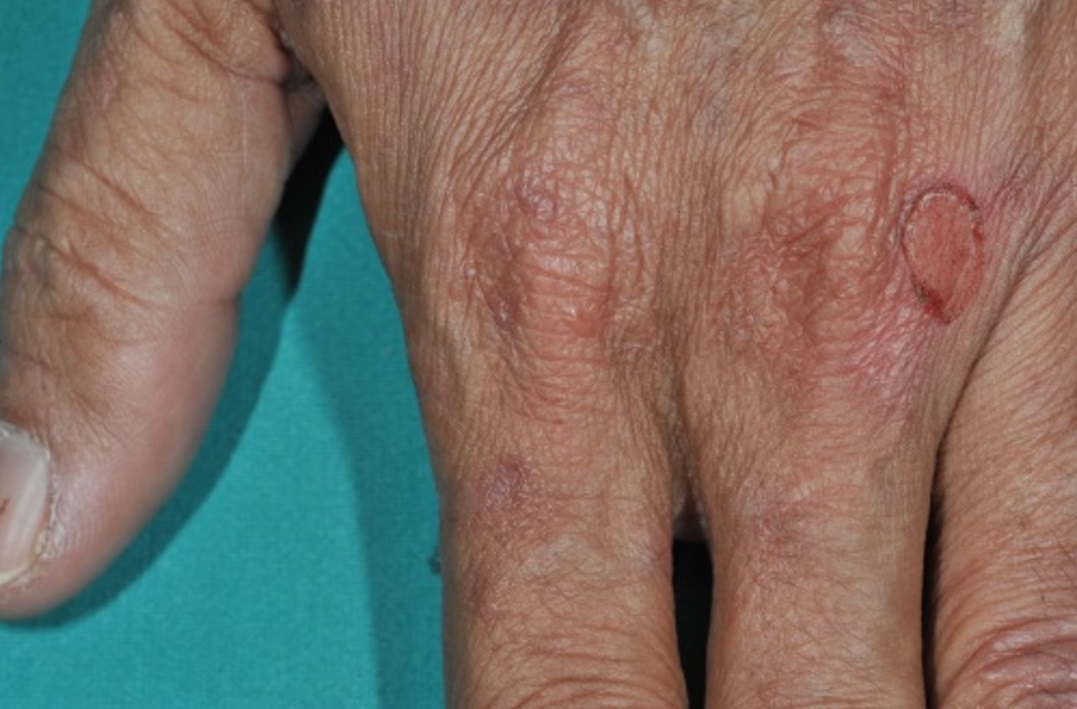The co-infection of Hepatitis C- and HIV associated with high risk of porphyria cutanea tarda: A case report and review of the literature
Keywords:
Porphyria cutanea tarda, Hepatitis C virus, Human immunodeficiency virusAbstract
Porphyria Cutanea Tarda (PCT) is caused by a deficiency of Uroporphyrinogen Decarboxylase (UROD). There are risk factors that promote the destruction of liver cells such as alcohol, estrogen, HIV, and hepatitis C virus. In PCT, the high levels of uroporphyrin in blood and urine are detected. In this case report, the male patient had a history of infection with hepatitis C and HIV simultaneously. His chief complaints were erythematous papules, blisters, and scars in the back of his hands. Laboratory tests revealed high levels of uroporphyrin in blood and urine. Histopathological examination showed subepidermal separation with festooning of dermal papillae. In conclusion, the presence of blisters and scars located on sun-exposed areas in the patient with history of hepatitis C and HIV infection should alert the physicians to be aware of PCT as one of the differential diagnosis.
References
Nagy Z, Kószó F, Pár A, et al. Hemochromatosis (HFE) gene mutations and hepatitis C virus infection as risk factors for porphyria cutanea tarda in Hungarian patients. Liver Int 2004; 24: 16-20.
Bernardes FF, Santos MV, Carvalho FN, et al. HAART: a risk factor for development of porphyria cutanea tarda? Rev Soc Bras Med Trop 2012; 45: 764-7.
Kushner JP, Barbuto AJ, Lee GR. An inherited enzymatic defect in porphyria cutanea tarda: decreased uroporphyrinogen decarboxylase activity. J Clin Invest 1976; 58: 1089-97.
Poh-Fitzpatrick MB. A plasma porphyrin fluorescence marker for variegate porphyria. Arch Dermatol 1980; 116: 543–7.
Hindmarsh JT, Oliveras L, Greenway DC. Plasma porphyrins in the porphyrias. Clin Chem 1999; 45: 1070-6.
O'Connor WJ, Badley AD, Dicken CH, Murphy GM. Porphyria cutanea tarda and human immunodeficiency virus:two cases associated with hepatitis C. Mayo Clin Proc 1998; 73: 895-7.
Celesia BM, Onorante A, Nunnari G, et al. Porphyria cutanea tarda in an HIV-1-infected patient after the initiation of tipranavir/ritonavir:case report. AIDS 2007; 21: 1495-6.
Egger NG, Goeger DE, Payne DA, Miskovsky EP, Weinman SA, Anderson KE. Porphyria cutanea tarda:multiplicity of risk factors including HFE mutations, hepatitis C, and inherited uroporphyrinogen decarboxylase deficiency. Dig Dis Sci 2002; 47: 419-26.
Murphy A, Dooley S, Hillary IB, Murphy GM. HCV infection in porphyria cutánea tarda. Lancet 1993; 341: 1534-5.
Lacour JP, Bodokh I, Castanet J, Bekri S, Ortonne JP. Porphyria cutanea tarda and antibodies to hepatitis C virus. Br J Dermatol 1993; 128: 121-3.
Gisbert JP, Garcia-Buey L, Pajares JM, Moreno-Otero R. Prevalence of hepatitis C virus infection in porphyria cutanea tarda:systematic review and meta-analysis. J Hepatol 2003; 39: 620-7.

Downloads
Published
How to Cite
Issue
Section
License
เนื้อหาและข้อมูลในบทความที่ลงตีพิมพ์ในวารสารโรคผิวหนัง ถือเป็นข้อคิดเห็นและความรับผิดชอบของผู้เขียนบทความโดยตรงซึ่งกองบรรณาธิการวารสาร ไม่จำเป็นต้องเห็นด้วย หรือร่วมรับผิดชอบใดๆ
บทความ ข้อมูล เนื้อหา รูปภาพ ฯลฯ ที่ได้รับการตีพิมพ์ในวารสารโรคผิวหนัง ถือเป็นลิขสิทธิ์ของวารสารฯ หากบุคคลหรือหน่วยงานใดต้องการนำทั้งหมดหรือส่วนหนึ่งส่วนใดไปเผยแพร่ต่อหรือเพื่อกระทำการใดๆ จะต้องได้รับอนุญาตเป็นลายลักอักษรจากบรรณาธิการวารสารโรคผิวหนังก่อนเท่านั้น


